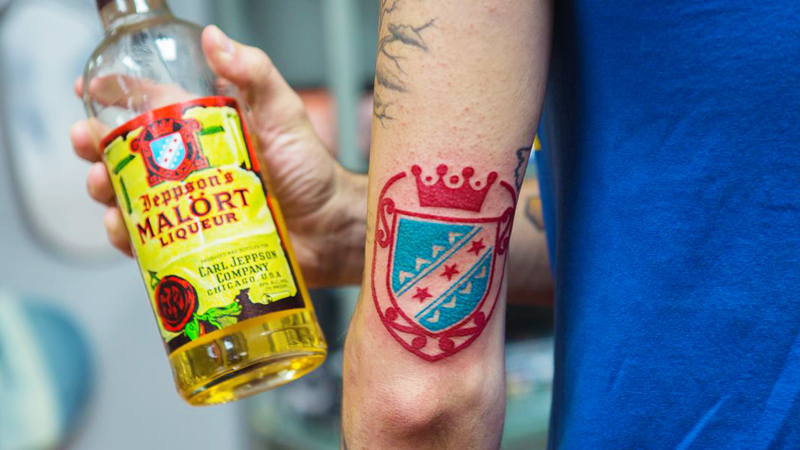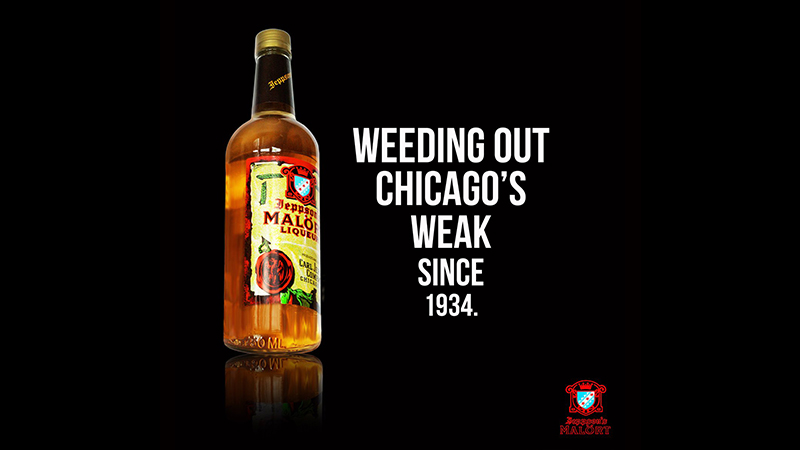Describe the Taste of Malort Funny
"Rotten grapefruit, sugar, and regret."
"Oh, this isn't too bad, it's kind of floral and light tasting! Oh, wait, it's legitimately furniture varnish."
"The ghost of a grapefruit that died under suspicious circumstances."
Those are some of the gentler responses you'll get if you ask people about Jeppsen's Malort, the Chicago spirit that has become an essential part of the city's drinking culture. Like PBR or flat caps, what was once the province of grizzled old men in dingy bars has been embraced by bearded hipsters in cocktail lounges.
It shows in Malort's inventory. Sales were up 80 percent in 2012 and have remained strong ever since.
Don't Miss A Drop
Get the latest in beer, wine, and cocktail culture sent straight to your inbox.
Malort was born in the early 1900s when a Swedish immigrant named Carl Jeppson took it upon himself to create his own version of a traditional bäsk brännvin (also known as besk), a bitter Scandinavian liquor flavored primarily with wormwood and originally meant to settle upset stomachs. Not being a creative sort, Jeppson called his drink "Malort," which is the Swedish word for wormwood.

Unlike absinthe, another famous wormwood-based drink, Jeppson's infusion didn't have any hallucinogenic properties — though really, neither does absinthe — nor did it have any of absinthe's additional ingredients, like anise or fennel, to balance out the pungent herbaceousness of the wormwood.
"It's just so one-note," Scott Stroemer, head bartender at Chicago's Pacific Standard Time, says. "Yes, this is what wormwood (and bulk neutral grain spirit, and probably toilet water) tastes like. Yes, it could use some sugar and acid."
It was that same off-putting taste, though, that allowed Jeppson's Malort to survive the national tragedy known as Prohibition. During the dry years, Jeppson sold his besk door-to-door as a "medicinal alcohol," allowing him to legally peddle the bitter brew. It's been said that any Fed who questioned him was offered a taste, after which they unanimously decided that no one would be drinking Malort for fun.
By the time the 18th Amendment was repealed, Malort was entrenched in the taste buds of the heavily Scandinavian population living on Chicago's North Side. Then in 1934, Jeppson sold his recipe to local lawyer George Brode, who viewed marketing the difficult spirit as a personal challenge. Brode grew the audience for Malort by introducing it to various immigrant populations throughout the city, bringing people of diverse backgrounds together with the classic pairing of grapefruit and gasoline.
Brode's other strategy for increasing his sales could have been the inspiration for the Old Spice-style advertising that controlled everything in the mid-aughts. Rather than trying to convince people to like it, the brand leaned into its divisive nature — early bottle hangers taunted prospective drinkers with questions like, "Are you man enough to drink Jeppson?" Print ads issued a "challenge to the braggart who says 'I can drink anything.'"
At one point, the label on the back of the bottle read:
Most first-time drinkers of Jeppson Malort reject our liquor. Its strong, sharp taste is not for everyone. Our liquor is rugged and unrelenting (even brutal) to the palate. During almost 60 years of American distribution, we found only 1 out of 49 men will drink Jeppson Malort. During the lifetime of our founder, Carl Jeppson was apt to say, 'My Malort is produced for that unique group of drinkers who disdain light flavor or neutral spirits.' It is not possible to forget our two-fisted liquor. The taste just lingers and lasts — seemingly forever. The first shot is hard to swallow! Perservere [sic]. Make it past two 'shock-glasses' and with the third you could be ours… forever.
The ads worked. Malort's status was cemented among working-class men (and women) who wanted to prove their mettle.
The brand chugged along for another few decades, during which Brode was honored by King Gustav IV Adolf of Sweden for helping to preserve Swedish culture, before being forced to relocate the distillery from Chicago to Florida in the late 1980s. In 1998, Brode, whose health was declining, stopped advertising the spirit. When he passed away in 1999, he left his pet project to his secretary, Pat Gabelick.
Gabelick ran things much as Brode had, relying on the brand's stable appeal in blue-collar neighborhoods rather than trying to embrace the burgeoning cocktail and spirits boom that was happening in other parts of the country — though, notes Stroemer, perhaps that was a wise decision.
"I've worked with dozens of bartenders who've tried to make Malort cocktails," he says. "It's like pushing yourself too far at the gym. I always insist they take home the rest of the bottle once they give up."

It was in the late 2000s when things started to change. With the rise of social media and incessant photo sharing, people were suddenly able to turn the singular experience of Malort into a documented badge of honor. Groups like Malort Face began popping up online. Soon there were fan-led contests to find the brand a new tagline ("Malort: kick your mouth in the balls" was the winner), and an unofficial Twitter and Facebook page that grew so fast that Gabelick ended up offering the creator a position as the brand's marketing director. Beloved pie shop Hoosier Mama even created a "Chicago Sunrise" pie made with grapefruit custard and the bracing spirit.
Despite thinking that Malort tastes "like grass that has spoiled," Cat Vielma, a native Chicagoan living in Colorado, says she orders Malort every time she comes home.
"It's mostly a masochistic homesickness, which for me is a good description of my years in Chicago," she says. "You're absolutely in love with the place while at the same time acknowledging that living in Chicago is one of the most masochistic things you can do — between winter, the mostly hapless Cubs, cost of living, and the impossibility of home ownership, it's urban masochism at its finest. Yet we all still love and live (or lived) in Chicago for the bits of joy, the summer festivals, concert scene, and grit that comes with being a Chicagoan.
"Malort is just that — masochistic grit in a shot glass," she adds. "It's disgusting, yet familiar. Painful, yet missed."
"I remember thinking I would never drink it again!" Natalia Cardenas, the beverage development manager at Breakthru Beverage Illinois, says of her first taste of Malort. "I was wrong."
More than anything else, Cardenas says, the appeal of Malort is related to its deep Chicago roots: "It's novelty and city pride for sure," she says. "We Chicagoans are extremely proud of our city. Drinking Malort has definitely become a rite of passage for any visitor or newcomer."
She's right. If you want a free shot in Chicago, just tell the bartender that you're new to the city and you've never tried Malort. They'll smirk, then pour you a measure of the golden-hued liquid and wait expectantly.
After all, you can't say that nobody warned you.
Source: https://vinepair.com/articles/malort-face-chicago/